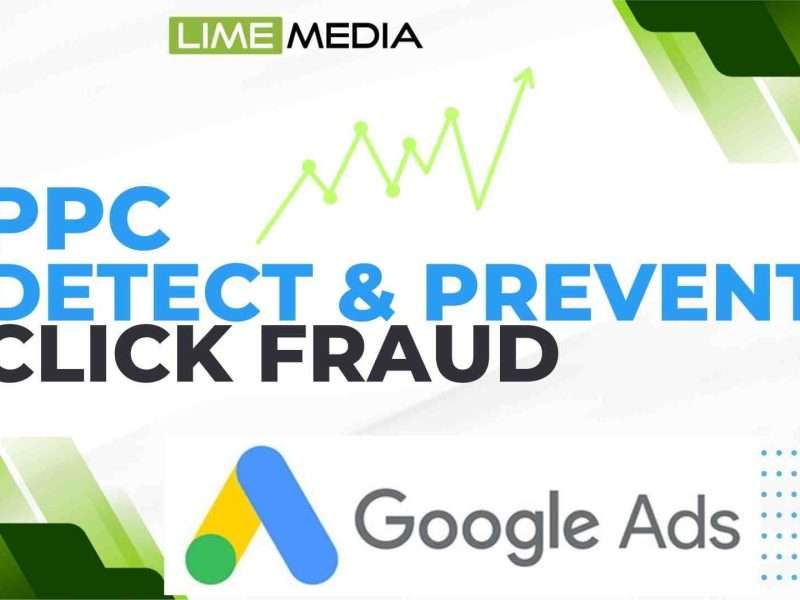Did you know that 84 billion dollars is the estimated global cost of ad fraud in 2025 alone.
Click fraud is a large-scale issue that businesses in the PPC world have to deal with. In particular small and medium sized companies report to be losing out to the tune of thousands each year which is money that could have gone towards real customer acquisition. Also, as digital ad spend grows, we are seeing this issue grow.
At LimeMedia.org, we have helped out with the diagnosis, prevention, and reduction of click fraud in Google PPC Ads for our worldwide clients which in turn allows them to protect their ad spending and scale their campaigns with confidence. In this guide on detecting and preventing fraud clicks, we will go over:
Table of Contents
What is Click Fraud?
Click Fraud simply dry out your advertising budget or skew your performance data in results you just get fake clicks and nothing in revenue, sales or profit.
Fraudulent clicks can happen in the case of competitors, or automated scripts (bots) are clicking your ads over-and-over to waste your budget.
Why do we care so much? Click fraud.
- Drains Budgets: Your spending is going to fake clicks instead of real prospects.
- Distorts ROI: When you get fraudulent clicks then your metrics look large but in fact they are not.
- Hurts Future Campaigns: Fraudulent activity taints learning algorithms, which in turn makes ad optimization a more difficult task.
In certain fields, we see that up to 90% of clicks are from fraud or bots.
Read Also: How to Structure, Optimize And Scale PPC Campaigns For Best ROI
Different Types of Click Fraud
To stop Fraud clicks you need to know the types of fraudulent clicks and these clicks take on many types, and to prevent it you must first know them out.
1. Robots.
Robotics Fraudulent Clicks is an automated program that simulates users’ actions to click on ads. Advanced botnets may consist of many thousands (to millions) of infected machines that produce fake activity of clicks.
2. Penny farms.
Large groups of low paid workers who are clicking on ads with the use of phones and desktops also which are based out of foreign locations. I’ve found that these groups are related to those who are working with Google AdSense they simply turn on the proxies on different devices and then make self-clicks on different ads.
3. Proxy server traffic.
Fraud which is run by criminals (Scamming Call Centers) who use proxy servers to hide their IP addresses and locations which in turn makes it hard for advertisers to tell between real and fake users.
4. Adversarial Clicking.
Competitors which are putting in effort to click on your ads in a negative way which in turn is reducing your daily budget and performance of your campaign.
5. D”data Centers.
Massive sets of computers that are out there for the purpose of putting up fake clicks. Though not always for ill intent, they do cause ad spend to go up which in turn does not bring in real customers as I mentioned before a types of clicks to gain revenue on AdSense.
6. Rewarded Views.
In rewarded views type of click fraud users get points and cash for clicking on ads and in result you aren’t seeing real conversion from this.
7. Ad Overlap.
Fraudsters put out many ads that appear to be one. A single click is recorded as many ad interactions as you pay for clicks which never connected with real prospects.
Read Also: Advanced Strategies for Gradual ROAS Target Changes in PPC
How to Detect Click Fraud
It is very hard to detect Click Fraud but not out of the question to detect and there are some steps you have to take to stop Fraudulent Clicks on Google PPC ads. Here’s a quick expert guide:
1. Examine Traffic Trends.
Look out for atypical increases in traffic from certain times, locations, or devices.
2. Click Through Rate vs Conversion Rate Check.
A high CTR with very low conversions is a sure sign of fraud.
3. Watch out for IP Addresses.
Repetitive activity from the same IP or a small range of IPs indicates bot-nets or farm.
4. Ban harmful IPs.
Google removed issue IP addresses from their Ads network which is to prevent the repeat of the abuse. You can also collect harmful IPs from your cPanel or using some paid tools and then put them in restrictions using GTM.
5. Divide Your Data.
To divide your data, collect it from the sources, and then break out your collected data by devices, geo, time, and source. Fraud, which is usually in the atypical segments.
6. Click Through Analysis.
Track that which is of value in engagement, we see that many leave very quickly and report in as invalid clicks.
7. Device Integrity Check.
Unexpected floods from devices your main audience doesn’t use? Likely fraud.
8. Review of Ad Placement Strategies.
Check where your display ads are going. Also note that fraud-prone sites are blowing up impressions and clicks.
9. Geosource Analysis.
Traffic to your target locations may be from farms or proxies.
10. Use Detection Tools.
Specialized monitoring tools that integrate with analytics and CRMs can identify anomalies at a faster rate than manual checks.
How to Prevent Ad Fraud
The PPC campaign security matters a lot, and you can prevent Ad Fraud for your Google PPC by using many different approaches, and some are mentioned below, so you can follow and secure your Google PPC campaign:
- Set IP Exclusions: Block out fraudulent IPs from campaigns.
- Refine Targeting: Refine your geo targeting and audience pools.
- Adjust Ad Scheduling: Fraud occurs at off hours which is when ads run.
- Cap Daily Budgets: Prevent competitors’ burnout of resources.
- Monitor Placements: Go to trusted websites and networks.
- Automate with Rules: Set up notifications for when there are large changes in CTR or reports of 0 conversions in ad groups.
- Integrate Behavioral Analytics: Microsoft Clarity tools, which report on what is meaningful to your site.
Read Also: Advanced PPC Conversion Tracking – How to Stop Losing Sales Data
LimeMedia.org is Preventing Businesses From Click Fraud.
At LimeMedia.org, we are a team of Google PPC Campaign experts with vast experience worldwide, and we provide in-depth PPC protection solutions with the following steps:
- Custom Fraud Audit: We review your campaigns, traffic sources, and click patterns for issues of waste.
- Conversion-First Setup: In Conversion we integrate (GA4, Zoho, HubSpot, Oribi, GHL, and Clarity) which means only quality leads will be counted as conversions.
- IP and Geo Blocking Strategies: We set up IP and Geo blocking strategies, which include exclusion of invalid clicks.
- Landing Page Behavior Analysis: Landing Page Activity Analysis via session recordings and heat maps, we identify real users from bots.
- Proactive Campaign Monitoring: Proactively in on our PPC we set rules, alerts and thresholds which in turn prevent fraud from silently eating away at your budget.
LimeMedia helps you notice, stop, and protect your ad spending in real time.
FAQs
1. How much of a problem is click fraud in PPC?
Click fraud is a larger issue than most businesses think. We see that as high as 20% of PPC ad clicks may be fraudulent for some industries. In finance, eCommerce, and legal services, we see even higher risks.
2. May we get refunds from Google or Meta for fraudulent clicks?
Yes, we see that both Google Ads and Meta Ads have in place auto detection and remediation for invalid clicks. But they don’t catch it all. That’s which having your own monitoring strategy in place (and to work with experts like LimeMedia.org) is key to getting back your lost spend.
3. What is the key sign of click fraud?
Key red flags include: Key indicators of which are sure things are mentioned below:
- Abrupt increases in clicks but no conversions.
- High CTR with very little engagement.
- Repetitive actions from the same IP or region.
- Traffic from unexpected geographies.
4. What is my ad budget affected by in terms of click fraud?
On average, businesses may see a 10 – 30% loss of their ad spend to fraud if they don’t have prevention measures in place. High spend advertisers may see that which translates into tens of thousands of dollars annually in wasted budget.
5. Can we totally prevent click fraud?
While we can’t put a stop to it fully, we can do a great job of minimizing and controlling it with proactive monitoring, smart exclusions and integrated conversion tracking. We aim to catch fraud at an early stage and prevent it from draining your budget.
6. Which tools are for click fraud detection and prevention?
Beyond what Google provides out of the box, we have advanced solutions which include:.
GA4 and Tag Manager for conversion integrity checks.
Zoho CRM, HubSpot, Oribi, and GHL for outscoring leads.
Microsoft Clarity: Detecting fake engagement through heatmaps and session replays.
At LimeMedia we have put together these tools in a single performance oriented framework which also minimizes fraud risk.
7. Do small businesses have to care about click fraud?
Absolutely. In fact, small and medium-sized businesses are the most affected as they have tighter budgets. Also, a loss of $500 – $1,000 per month to fake clicks is very damaging if not addressed.
Bottom Line: Click fraud exists, but it doesn’t have to empty your budget. With the proper preventative measures, conversion tracking, and dedicated watch and care from experts, we can transform PPC back into a growth tool which was for at large a waste of money.
Final Thoughts
Click fraud is a very present yet ignored issue in the world of PPC today. From bots to competitive opponents and shady networks, it is an issue that depletes budgets and taints campaign data.
Through the use of smart detection, proactive exclusions, and advanced conversion tracking, businesses can see results. If you think you have wasted budget in your PPC campaigns, get in touch with us at LimeMedia.org. We do an audit, optimization and will protect your ads so that each click is worth it.


